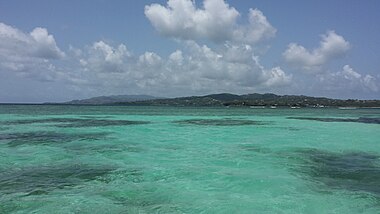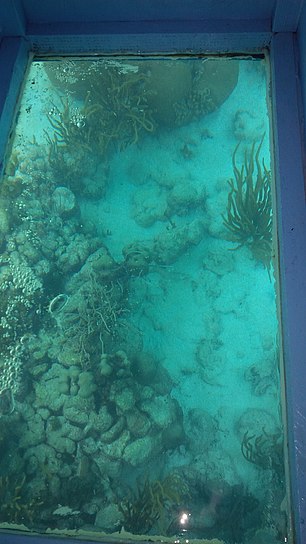Buccoo Reef

| Designations | |
|---|---|
| Official name | Buccoo Reef / Bon Accord Lagoon Complex |
| Designated | 8 July 2005 |
| Reference no. | 1496[1] |
The island of Tobago has multiple coral reef ecosystems.[2][3] The Buccoo Reef, the Culloden Reed and Speyside Reef are the three largest coral reef marine ecosystems in Tobago.[4] The Buccoo Reef is a coralline reef ecosystem that is located on the southwestern region of Tobago.[2][3][4] It is a popular ecotourism attraction where tourists can snorkel and see the coral reefs and schools of fish without diving equipment.[3][5][6] The Trinidad and Tobago Tourism Ministry estimates that 90% of its tourists visit the Buccoo Reef while exploring Tobago.[3] The Buccoo Reef, also known as the Buccoo Reef Complex, spans 7 km2 and has five reef flats that can reach up to 25 metres in depth.[2][4][7][8] The reef complex has been designated as part of a protected Ramsar site since 2005.[1]
In 1973, the Buccoo Reef Complex was designated as a protected marine park, called the Buccoo Reef Marine Park to monitor the health of the coral reef ecosystem.[2][4][8] Approximately 90% of Tobago's coastal shoreline is protected by coral reefs, including the Buccoo Reef Complex.[9][10][11] These coral reefs help protect Tobago's land from eroding and avoiding landslides.[12] In 1999, a non-profit organization called the Buccoo Reef Trust was created to help the Trinidad and Tobago government in developing its marine education department and organizing sustainability projects, including the preservation of the Buccoo Reef Complex and other coral reefs.[13][14]
The Buccoo Reef Complex is made up of a shallow lagoon, seagrass beds and a mangrove wetland.[7] The dominant corals in the Buccoo Reef Complex are the Montastrea species, the thin finger (Porites divaricata) corals and the fire corals (Millepora species).[15] In this region, the coral reefs experience two seasons: the dry season, which spans from January to May, and the wet season, which spans from June to December.[16][17] Sea surface temperatures in the Buccoo Reef Complex range between 26 °C to 31 °C.[16][17][18] The Buccoo Reef complex receives freshwater and nutrients from the Orinoco River.[19][7][18][20] The nutrient flow from the Orinoco River allow the proliferation of plankton.[18][20] Approximately 119 species of fish inhabit the Buccoo Reef Complex.[3][9] These fish species benefit from the pool of plankton and they use the Buccoo Reef Complex to spawn and regenerate their populations.[3][9][18]

Since 1970, the Buccoo Reef Complex has been declared at risk by marine scientists due to the rise of pollution, poor water quality, eutrophication and coral bleaching[8][19][21][22][23] Approximately 28% of coral cover in the Buccoo Reef Marine Park has decreased from 1994 to 2008.[22] Coral reef health has also declined during this period due to sedimentation, nutrient runoff from and thermal stress from urbanization in Tobago.[2][4][18][24][25] Three major coral bleaching events occurred in Tobago in 1998, 2005 and 2010 that also affected the coral cover of many coral reefs, including the Buccoo Reef.[19][7][16][24][26] Following the bleaching event in 2005, the Buccoo Reef Trust conducted a study on the impact of bleaching event on all coral reefs across Tobago.[15] It was found that many of the dominant corals in the Buccoo Reef Complex were significantly bleached.[15] After the 2010 coral bleaching event in Tobago, the overall hard coral taxa cover has decreased from 25.19% in 2010 to 16.38% in 2012 at the Buccoo Reef Complex.[7] Over the 2010–2012 period, macroalgae species increased from 15.87% cover to 37.90% cover in the Buccoo Reef Complex.[7]
References
- ^ a b "Buccoo Reef / Bon Accord Lagoon Complex". Ramsar Sites Information Service. Retrieved 25 May 2020.
- ^ a b c d e Lapointe, Brian E.; Langton, Richard; Bedford, Bradley J.; Potts, Arthur C.; Day, Owen; Hu, Chuanmin (2010-03-01). "Land-based nutrient enrichment of the Buccoo Reef Complex and fringing coral reefs of Tobago, West Indies". Marine Pollution Bulletin. 60 (3): 334–343. Bibcode:2010MarPB..60..334L. doi:10.1016/j.marpolbul.2009.10.020. ISSN 0025-326X. PMID 20034641.
- ^ a b c d e f "Tobago's major tourist attraction..." www.guardian.co.tt. Retrieved 2020-03-18.
- ^ a b c d e Buglass, Salome; Donner, Simon D.; Alemu I, Jahson B. (2016-03-15). "A study on the recovery of Tobago's coral reefs following the 2010 mass bleaching event". Marine Pollution Bulletin. 104 (1): 198–206. Bibcode:2016MarPB.104..198B. doi:10.1016/j.marpolbul.2016.01.038. hdl:2429/51752. ISSN 0025-326X. PMID 26856646.
- ^ "Tobago bucket list: 10 things you must do on the island before you die". www.looptt.com. Retrieved 2020-03-19.
- ^ "Where are the best hidden beaches in Tobago?". The Telegraph. 2019-07-24. ISSN 0307-1235. Retrieved 2020-03-19.
- ^ a b c d e f Alemu I, Jahson Berhane; Clement, Ysharda (2014-01-06). Dias, João Miguel (ed.). "Mass Coral Bleaching in 2010 in the Southern Caribbean". PLOS ONE. 9 (1): e83829. Bibcode:2014PLoSO...983829A. doi:10.1371/journal.pone.0083829. ISSN 1932-6203. PMC 3882216. PMID 24400078.
- ^ a b c Lapointe, B. E.; Langton, R.; Day, O.; Potts, A. C. (2003). "Integrated water quality and coral reef monitoring on fringing reefs of Tobago: chemical and ecological evidence of sewage-driven eutrophication in the Buccoo Reef Complex" (PDF): 457–472.
{{cite journal}}: Cite journal requires|journal=(help) - ^ a b c Ramsaroop, Doon (1982-12-31). "A preliminary survey of the coral reefs in Man-o-War Bay, Tobago". Living World, Journal of the Trinidad and Tobago Field Naturalists' Club.
- ^ "Tobago's coral bleaching alert makes it clear there is 'no alternative' to fighting the climate crisis · Global Voices". Global Voices. 2019-09-15. Retrieved 2020-03-19.
- ^ "Shoreline Protection by Coral Reefs - Tobago". World Resources Institute. 2008-06-11. Retrieved 2020-03-19.
- ^ Burke, Lauretta Marie, contributor. Greenhalgh, Suzie, contributor. Prager, Daniel, contributor. Cooper, Emily, contributor. Coastal capital, Tobago : the economic contribution of Tobago's coral reefs. OCLC 919637127.
{{cite book}}:|last=has generic name (help)CS1 maint: multiple names: authors list (link) - ^ "Buccoo Reef Trust – Buccoo Reef Trust". Retrieved 2020-03-19.
- ^ Armstrong, Hyacinth G. (2005). "Environmental education in Tobago's primary schools: a case study of coral reef education", Revista de Biología Tropical, 53(Suppl. 1), 229–238. Retrieved 2020-03-19.
- ^ a b c O’Farrell, S. and Day, O. 2005. "Report on the 2005 mass coral bleaching event in Tobago: Part 1. Results from Phase 1 Survey". 2005. pp. 1–42.
- ^ a b c Mohammed, Shaazia; Heron, Scott; Mahabir, Rajindra; Clarke, Ricardo (2015-12-24). "Performance Evaluation of CRW Reef-Scale and Broad-Scale SST-Based Coral Monitoring Products in Fringing Reef Systems of Tobago". Remote Sensing. 8 (1): 12. Bibcode:2015RemS....8...12M. doi:10.3390/rs8010012. ISSN 2072-4292.
- ^ a b "Climate". www.metoffice.gov.tt. Retrieved 2020-03-18.
- ^ a b c d e "Tobago's Reefs – Buccoo Reef Trust". Retrieved 2020-03-18.
- ^ a b c Hassanali, Kahlil (2013). "Towards sustainable tourism: The need to integrate conservation and development using the Buccoo Reef Marine Park, Tobago, West Indies". Natural Resources Forum. 37 (2): 90–102. doi:10.1111/1477-8947.12004. ISSN 1477-8947.
- ^ a b Muller-Karger, Frank E.; McClain, Charles R.; Richardson, Philip L. (May 1988). "The dispersal of the Amazon's water". Nature. 333 (6168): 56–59. Bibcode:1988Natur.333...56M. doi:10.1038/333056a0. ISSN 1476-4687. S2CID 4371215.
- ^ Mallela, Jennie; Parkinson, Richard; Day, Owen (January 2010). "An assessment of coral reefs in Tobago". Caribbean Journal of Science. 46 (1): 83–87. doi:10.18475/cjos.v46i1.a10. ISSN 0008-6452. S2CID 87505578.
- ^ a b Mohammed, Azad; Mohammed, Terry; Alemu, Jahson; White, Stephanie; Gobin, Judith (2019-01-01). Sheppard, Charles (ed.). "Chapter 24 - Trinidad and Tobago". World Seas: An Environmental Evaluation (Second Edition). Academic Press: 567–590. doi:10.1016/b978-0-12-805068-2.00029-2. ISBN 978-0-12-805068-2. Retrieved 2020-03-19.
- ^ Burke, Lauretta (2016-06-08). "A History of Untreated Sewage Sours Tobago's Waters". World Resources Institute. Retrieved 2020-03-19.
- ^ a b Eakin, C. Mark; Morgan, Jessica A.; Heron, Scott F.; Smith, Tyler B.; Liu, Gang; Alvarez-Filip, Lorenzo; Baca, Bart; Bartels, Erich; Bastidas, Carolina; Bouchon, Claude; Brandt, Marilyn (2010-11-15). Romanuk, Tamara Natasha (ed.). "Caribbean Corals in Crisis: Record Thermal Stress, Bleaching, and Mortality in 2005". PLOS ONE. 5 (11): e13969. Bibcode:2010PLoSO...513969E. doi:10.1371/journal.pone.0013969. ISSN 1932-6203. PMC 2981599. PMID 21125021.
- ^ Potts, A. C.; Sandy, K.; Clarke, M.; Bobb, N. (2004). "The coral reefs of Tobago: status and management; Los arrecifes de Tobago: condiciones y manejo": 765–776.
{{cite journal}}: Cite journal requires|journal=(help) - ^ Harding, S.; van Bochove, J. W.; Day, O.; Gibson, K.; Raines, P. (2008). "Continued degradation of Tobago's coral reefs linked to the prevalence of coral disease following the 2005 mass coral bleaching event". Proceedings of the 11th International Coral Reef Symposium: 738–741.
